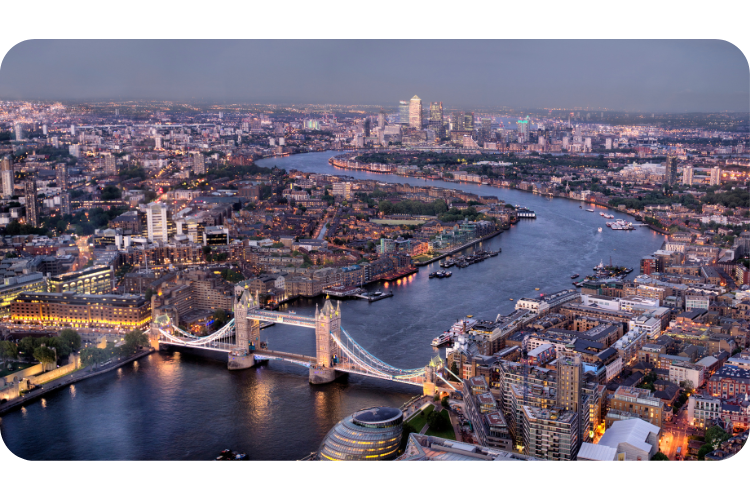On the 17th November 2022, we attended a seminar in London to review the progress of the Thames Estuary Growth.
The day was Chaired by Phil Laycock who has built the impressive Built Environment Network, which has already lined up a fascinating list of topics for 2023.
Here are the key points raised by the some of the speakers.
Kate Willard OBE, led from The Thames Estuary Growth Board and she gave a forceful and enthusiastic presentation which got the audience fired up.
She highlighted that 43% of the imports from Mexico come into the Estuary Ports. She said that she was invited to lunch with the Mexican ambassador the following day and thought, “What would we need to do to make it 60% of their imports?”. It’s that type of simple approach which makes her appealing and a great envoy for the Thames Estuary.
Kate also reported on the importance of investors and said that what they need is:
- Long-term relationships
- Scale
- A single point of contact
Caroline Harper, of Be First London, runs the planning authority from the London Borough of Barking and Dagenham. She said that the borough has the worst economic performance in the country but does have the best planning authority.
She said that they must be pragmatic and insists that planning reform is the only way to get things done in the Thames Estuary.
Shona Richardson, of Homes England said that the social infrastructure is needed to accompany new homes. She said that in order to build homes, you must have jobs, and with this is mind, it shouldn’t matter if they are in the adjoining borough.
Levelling up requires you to consider:
- Housing
- Pride of place
- Well being
- Transport connectivity
- Employment
- Productivity
Tom Reynolds, of Gravesham Borough Council gave a presentation which built on the points made by Shona Richardson.
He revealed that the council owns 11 km of riverside land and showed an excellent scheme. This confirmed that the Council were thinking about all of the functions of good development.
Shamaz Alibahn of Man GPM, Residential Developers said that their objectives were to dramatically improve the quantity of affordable homes in the proves of development.
He gave a number of examples which were promising.
Carla Guerrara, CEO of Purpose Driven Developments said that she was an urban planner who was now in development. She explained that there were a number of similarities between the Thames Estuary and the development of the waterfront in Toronto, Canada.
She had been appointed to make a contribution to the “Green Blue Vision” for the Thames Estuary Growth Board. The following key points had been established:
- Net Zero – Catalyse a hydrogen ecosystem that meets some of the Thames Estuary’s energy demands.
- Build back better – Change the infrastructure and develop for the booming industries and the Thames Freeport.
- Places and spaces – encourage growth and development in the Estuary, while protecting its natural assets respecting it beauty.
- Accelerating investment – ensure that the reality relates to the vision.
Simon Barnes, Strategic Partnership Manager for the University of Kent, said that 20-25% of the Thames Estuary energy needs could be met by the development of hydrogen.
Our summary of the conference
The most important lessons to be learnt from this conference were:
- Talk to people. Most of the organisations in the Thames Estuary cannot achieve anything on their own. They must form partnerships with others, and they must talk, little and often is the key!
- Investors need other people to take action and to make sure the project is viable. This is why they must have a long-term relationship and a single point of contact. The most important thing for funders is to build trust.
- Planning reforms is essential. The only way to develop anything of the nature of the Thames Estuary, which has several “fixed points “and others which are free to develop, is to think creatively about the spaces.
- It is important to protect and improve the environment to give it vitality. This is particularly important to riverside property, where sports and recreation are essential to give people more access to the water. Wildlife is also essential to give the environment that element of “repair”.
- Social infrastructure is essential to development. No longer can we build homes without giving due consideration to jobs, school places, doctor’s surgeries, hospital places and the like. This means thinking beyond the local authority boundaries and, indeed, outside of the confines of single developments, which are usually limited by their site. Elements of infrastructure can be provided by different projects and different developers.
- Levelling-up is a complex matter, which will benefit some regions that may have been thought affluent. It must take account of transport connectivity coma employment, productivity and anything associated with the well-being of the community.
- In the long run, housing development must get the right balance between affordable housing and the rest. Since this is an important ratio, which affects the profitability of the scheme it is worth spending time to get the balance right. Getting more affordable housing increases your likelihood of getting planning permission.
- Hydrogen is ideal for the estuary because storage and distribution is an issue that needs to be resolved. the water makes it easier to distribute it safely. However hydrogen is difficult to manufacture and another the speakers emphasised that it needs experimentation to get the right process. this means that the developers, their advisors end partners must have patience, make compromises end get seed capital for the development.
All of these points can be resolved in the Thames Estuary providing people communicate well and continue to do so. It is only through partnerships (in the widest definition of the term) that the Estuary will succeed.
Paul Wilson
